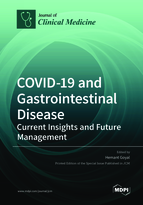COVID-19 and Gastrointestinal Disease: Current Insights and Future Management
A special issue of Journal of Clinical Medicine (ISSN 2077-0383). This special issue belongs to the section "Gastroenterology & Hepatopancreatobiliary Medicine".
Deadline for manuscript submissions: closed (20 June 2022) | Viewed by 31109
Special Issue Editor
Special Issues, Collections and Topics in MDPI journals
Special Issue Information
Dear Colleagues,
COVID-19 is the most prominent and rapidly evolving public health concern in the world currently. The gastrointestinal manifestations of COVID-19 are increasingly being recognized. SARS-CoV-2 infection has been associated with the occurrence of nausea, vomiting, and diarrhea. SARS-CoV-2 has also been causing pancreatic and hepatic injury. Emerging data have shown that COVID-19 patients continue to shed the virus into their stools, even when patients test negative for COVID-19 in pulmonary secretions. However, the epidemiology, pathogenesis, and treatment of SARS-CoV-2-related gastrointestinal manifestations are poorly understood.
The pandemic has also had a significant impact on gastroenterologists, endoscopists, and other ancillary staff. Moreover, in the past, systematic respiratory virus syndrome (SARS) was shown to be transmitted by endoscopes, which is a big concern with COVID-19, as it shares many pathological features with SARS. The deferral of elective endoscopic procedures has negatively affected gastroenterologists.
This Special Issue focuses on the current situation of this pandemic. It aims to provide insight into the gastrointestinal manifestations of COVID-19 and its effects on endoscopic procedures. I believe that this issue will be beneficial not only for gastroenterologists but also other healthcare workers around the world to recognize the often-ignored clinical gastrointestinal manifestations of COVID-19.
Dr. Hemant Goyal
Guest Editor
Manuscript Submission Information
Manuscripts should be submitted online at www.mdpi.com by registering and logging in to this website. Once you are registered, click here to go to the submission form. Manuscripts can be submitted until the deadline. All submissions that pass pre-check are peer-reviewed. Accepted papers will be published continuously in the journal (as soon as accepted) and will be listed together on the special issue website. Research articles, review articles as well as short communications are invited. For planned papers, a title and short abstract (about 100 words) can be sent to the Editorial Office for announcement on this website.
Submitted manuscripts should not have been published previously, nor be under consideration for publication elsewhere (except conference proceedings papers). All manuscripts are thoroughly refereed through a single-blind peer-review process. A guide for authors and other relevant information for submission of manuscripts is available on the Instructions for Authors page. Journal of Clinical Medicine is an international peer-reviewed open access semimonthly journal published by MDPI.
Please visit the Instructions for Authors page before submitting a manuscript. The Article Processing Charge (APC) for publication in this open access journal is 2600 CHF (Swiss Francs). Submitted papers should be well formatted and use good English. Authors may use MDPI's English editing service prior to publication or during author revisions.
Keywords
- COVID-19
- SARS-CoV-2
- gastroenterology
- gastrointestinal manifestations
- endoscopy
- pancreatitis
- hepatitis







